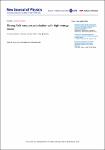Strong-field vacuum polarisation with high energy lasers
| dc.contributor.author | Macleod, AJ | |
| dc.contributor.author | Edwards, JP | |
| dc.contributor.author | Heinzl, T | |
| dc.contributor.author | King, B | |
| dc.contributor.author | Bulanov, SV | |
| dc.date.accessioned | 2023-09-08T17:49:13Z | |
| dc.date.available | 2023-09-08T17:49:13Z | |
| dc.date.issued | 2023-09-01 | |
| dc.identifier.issn | 1367-2630 | |
| dc.identifier.issn | 1367-2630 | |
| dc.identifier.other | 093002 | |
| dc.identifier.uri | https://pearl.plymouth.ac.uk/handle/10026.1/21297 | |
| dc.description.abstract |
When photons propagate in vacuum they may fluctuate into matter pairs thus allowing the vacuum to be polarised. This linear effect leads to charge screening and renormalisation. When exposed to an intense background field a nonlinear effect can arise when the vacuum is polarised by higher powers of the background. This nonlinearity breaks the superposition principle of classical electrodynamics, allowing for light-by-light scattering of probe and background photons mediated through virtual pairs dressed by the background. Vacuum polarisation is a strong-field effect when all orders of interaction between the virtual pair and the background must be taken into account. In this investigation we show that multiple scattering processes of this type may be observed by utilising high-energy laser pulses with long pulse duration, such as are available at facilities like ELI Beamlines. In combination with appropriate sources of high-energy probe photons, multiple probe-background light-by-light scattering allows for testing the genuine nonlinear regime of strong-field quantum electrodynamics. This provides access to the uncharted non-perturbative regime beyond the weak-field limit. | |
| dc.format.extent | 093002-093002 | |
| dc.publisher | IOP Publishing | |
| dc.subject | vacuum birefringence | |
| dc.subject | strong field physics | |
| dc.subject | high energy physics | |
| dc.subject | helicity flip | |
| dc.subject | high power lasers | |
| dc.title | Strong-field vacuum polarisation with high energy lasers | |
| dc.type | journal-article | |
| dc.type | Article | |
| plymouth.author-url | https://www.webofscience.com/api/gateway?GWVersion=2&SrcApp=PARTNER_APP&SrcAuth=LinksAMR&KeyUT=WOS:001058570300001&DestLinkType=FullRecord&DestApp=ALL_WOS&UsrCustomerID=11bb513d99f797142bcfeffcc58ea008 | |
| plymouth.issue | 9 | |
| plymouth.volume | 25 | |
| plymouth.publication-status | Published | |
| plymouth.journal | New Journal of Physics | |
| dc.identifier.doi | 10.1088/1367-2630/acf1c0 | |
| plymouth.organisational-group | |Plymouth | |
| plymouth.organisational-group | |Plymouth|Faculty of Science and Engineering | |
| plymouth.organisational-group | |Plymouth|Faculty of Science and Engineering|School of Engineering, Computing and Mathematics | |
| plymouth.organisational-group | |Plymouth|REF 2021 Researchers by UoA | |
| plymouth.organisational-group | |Plymouth|Users by role | |
| plymouth.organisational-group | |Plymouth|Users by role|Academics | |
| plymouth.organisational-group | |Plymouth|REF 2021 Researchers by UoA|UoA10 Mathematical Sciences | |
| plymouth.organisational-group | |Plymouth|REF 2021 Researchers by UoA|ZZZ Extended UoA 10 - Mathematical Sciences | |
| dcterms.dateAccepted | 2023-08-18 | |
| dc.date.updated | 2023-09-08T17:49:02Z | |
| dc.rights.embargodate | 2023-9-12 | |
| dc.identifier.eissn | 1367-2630 | |
| dc.rights.embargoperiod | forever | |
| rioxxterms.versionofrecord | 10.1088/1367-2630/acf1c0 |


